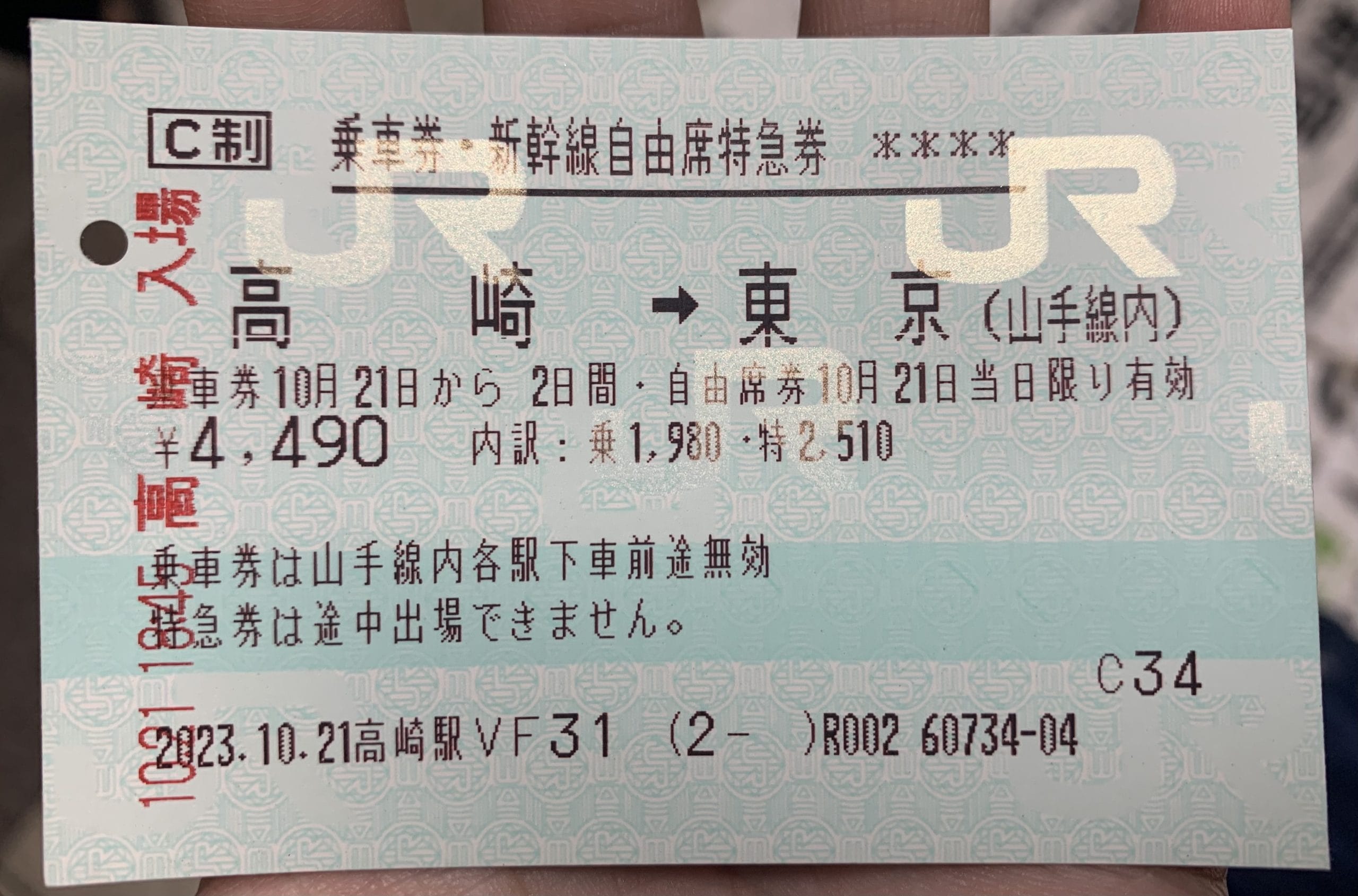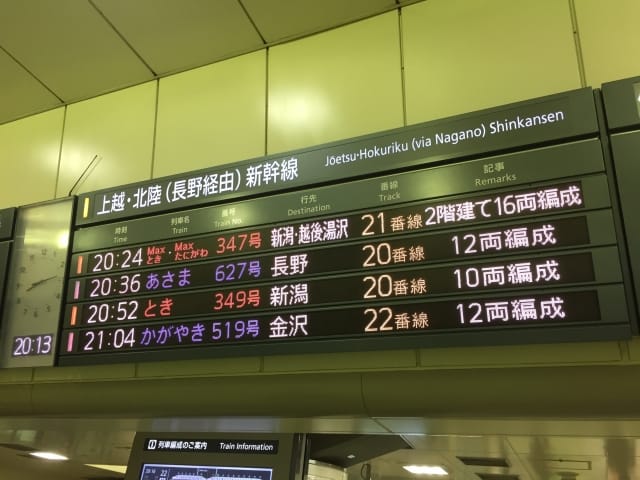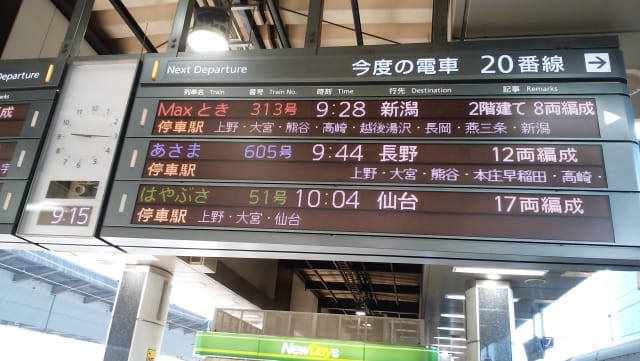Ever held a Shinkansen ticket but felt lost about where to board? This often happens when you’ve purchased a non-reserved seat ticket. In this guide, we’ll walk you through how to make the most of your non-reserved ticket for a smooth and stress-free Shinkansen experience in Japan.
What Is a Non-Reserved Shinkansen Ticket?
When buying a Shinkansen ticket, you might notice that it doesn’t include a specific train number, departure time, or seat information. This typically means you’ve purchased a non-reserved ticket, allowing you to board any train with non-reserved cars running between your starting and ending stations on the travel date. However, this only applies to trains with non-reserved seating options.

For instance, the ticket above is valid for travel from Takasaki to Tokyo on any Shinkansen with non-reserved seating on October 21. Simply head to the station on that day, find a train heading to Tokyo, and enter a non-reserved car. You’re free to take any available seat but cannot sit in reserved or premium sections.
Japan Pocket Wifi Rental
UNLIMTED DATA SIM CARD
Japan Travel Prepaid SIM card
Non-reserved tickets offer flexibility, making them ideal for travelers with open schedules. However, during peak seasons or busy hours, you might need to queue or even stand if all seats are taken. While it’s a convenient option, those with large luggage may find standing uncomfortable.
Note: Some trains, such as the Nozomi, only offer reserved seating. Be sure to check if the train you’re planning to board has non-reserved cars.
How to Find Your Train and Platform Information
If you’re new to the Shinkansen, the lack of platform details on your ticket might seem confusing. Don’t worry! With a little attention to station signage and facilities, you’ll easily locate the right train:
- Electronic Display Boards: Stations have electronic boards near the main hall or ticket gates showing train schedules, destinations, and stop information. Even if your non-reserved ticket doesn’t include a train number, these boards will guide you to the correct train.
- Platform Timetables: Once on the platform, electronic screens list incoming trains and indicate which cars are for non-reserved seating.
- Mobile Apps: Download apps like “JR East” or “Yahoo! Transit” to check train schedules and platform details anytime.
- Station Staff: If you’re still unsure, don’t hesitate to ask station staff for help. They’re usually very friendly and happy to assist.

For example, in the image above, a Shinkansen heading to Nagano (train number Asama 627) departs from Platform 20 at 8:36 PM.
Three Key Points for Using Non-Reserved Seats
To avoid any hiccups while using a non-reserved ticket, keep these tips in mind:
- Choose the Right Train: Not every train stops at all stations along your route. For example, the Nozomi and some express trains may skip smaller stops. Check the schedule to ensure your train stops at your destination.
- Queue Early: Non-reserved seats are first-come, first-served. During busy hours or popular routes, arrive early to secure a seat.
- Pay Attention to Directions: Some train names might look similar but head in different directions. For example, on the Tokaido Shinkansen, one train might go to Nagoya while another heads to Osaka. Double-check the destination before boarding.
Note: Trains departing from the same platform may have different destinations. For instance, Platform 20 at Tokyo Station may see trains heading to Niigata, Nagano, and Sendai within 30 minutes. Be sure to board the correct train for your destination.

How to Confirm if a Train Stops at Your Destination
Check the platform’s digital signboards. For example, the board at Platform 20 in Tokyo Station shows that the Max Toki 313 Shinkansen departing at 9:28 AM stops at multiple stations, including Ueno, Omiya, and Niigata. Meanwhile, the Hayabusa 51 Shinkansen departing at 10:04 AM only stops at Ueno and Omiya before heading directly to Sendai.
How to Choose the Best Train
Holding a non-reserved ticket but unsure which train to take? Here are a few practical tips:
- Avoid Peak Hours: Morning (7–9 AM) and evening (5–7 PM) are peak commute times. Non-reserved cars tend to be crowded, so traveling outside these hours is recommended.
- Check Non-Reserved Cars: The number of non-reserved cars varies by train, usually ranging from 1 to 3. Look for signs on the platform indicating car numbers.
- Use Official Resources: Information desks in JR stations often offer multilingual support. Staff can confirm train schedules and platforms for you.
Tips for Non-Reserved Travelers
Here are a few additional tips to make your Shinkansen journey smoother:
- Arrive Early: Non-reserved seating operates on a first-come, first-served basis. Arriving early during peak times or holidays increases your chances of getting a seat.
- Know the Car Layout: Some trains have fewer non-reserved cars. Check the train’s layout in advance to position yourself strategically on the platform.
- Stay Flexible: If a train’s non-reserved seats are full, consider waiting for the next one. The interval between trains is often short.
Advantages of Reserved Seating

Unlike non-reserved seating, reserved tickets guarantee a specific seat and car, saving you from the hassle of searching for an available spot. This option is especially beneficial for travelers with heavy luggage or those seeking a more comfortable journey. For popular trains like the Nozomi, it’s advisable to book in advance.
Reserved tickets can be purchased easily at station ticket counters, vending machines, or online platforms like Eki-net, SmartEX, or e5489. For a premium experience, consider Green Cars, which offer wider seats and extra services, perfect for long-distance trips.
Recommended Reading:
Japan Shinkansen Ticket Purchase & Riding Guide: A Must-Read for First-Time Visitors
Japan Pocket Wifi Rental
UNLIMTED DATA SIM CARD
Japan Travel Prepaid SIM card



